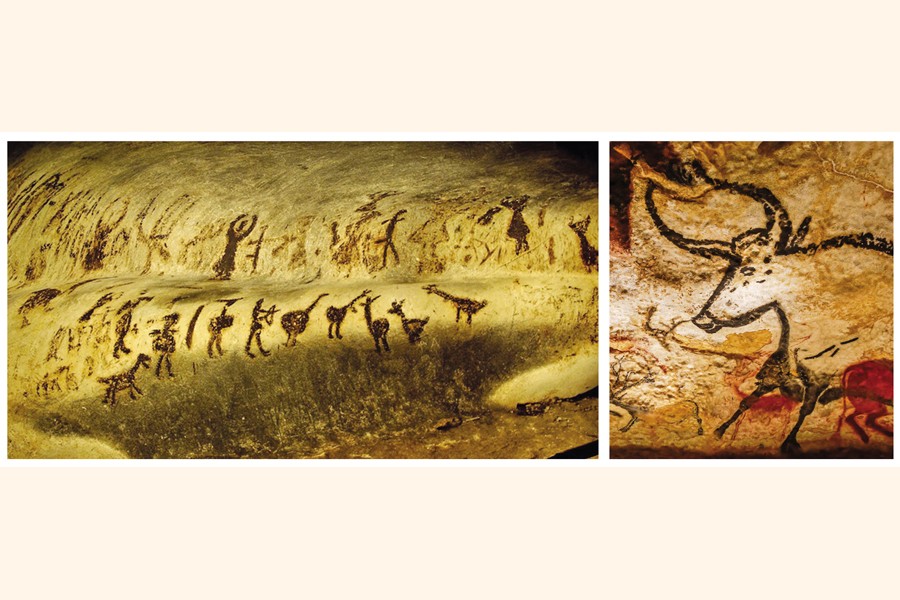
Published :
Updated :

Art is as old as time, and older than history and human civilization. For a long time since the emergence of humans on the face of Earth, homosapiens had used signs, symbols and carvings as means of communications. The ancient forms of artworks, thus, shaped economic activity, societal behaviours and culture.
To this day, art goes on creating aesthetic as well as economic value. Artworks themselves sell, generate employment and add value to economic products. Industrial art is almost intertwinned with production design and promotion.
In the printing and clothing industry, for an example, the output is greatly enhanced in getup.
As human society and economic order have evolved over the ages so has art and culture. Art has progressed on higher stages as socioeconomic situation developed. Yet, the influence of primordial and medieval genres of art is reflected in modern art, which can be crystal clear in an art-connoisseur's eye.
Now it's time we delved into the roots of art--how it came about, developed and influenced human society. This, to my mind, is a debt I, as a learner of arts, should pay to the artisans and artists of the days long, long gone by.
As a student of Art-History, prehistoric art always fascinates me. History of art dates long before human civilization.
It is surprising to note that humankind has been making art for at least 100,000 years! The reason I want to write about art-history is people do not value art if they don't know how art motivated history, beliefs and shaped the lives of ancient people. At first we are going way back before the first civilization. Prehistory! We are seeking the true intention and purpose of art and its cultural, spiritual, psychological, philosophical, symbolic, conceptual impacts on ancient people.
What does the oldest known art in the world tell us about the people who created it? They were basically hunter-gatherer people, lived a nomadic life mostly. They used art forms as a reflection of one of humans' earliest forms of communications. These images may have been symbolic, abstract at first but later they depicted animals, people and hybrid figures.
An interesting fact is homosapiens is not only one species who created cave art! Denisovans and Neanderthals also created cave art at least 64,000 years ago.
Another question can arise as to how the people who lived in the era of prehistory were like. When we think about stone age, most of what comes to mind is cavemen, Neanderthals just eking out survivals covered in furs maybe! At that time, the stone-age artisans were taking pigments mixed in their mouth and spraying it on simple shapes like their hands and other things to create images on the wall. But even before the end of the last ice age, we start seeing gorgeous sophisticated images like Altamira cave, Spain and Lascaux, and France. Now some of these images have become so famous, so well-known to us that we actually fail to consider their deeper cultural implications and how they actually challenged some of our notions of the stone age.
Let's take for example here the Lascaux caves. In those caves, you see, very common pigments like chalk, red clay, yellow clay, even charcoal, that have been used from burned wood. But now these pigments have been taken chemical analysis and we know that some of that blacks are actually a very rare form of Manganese called Haussmannite. Even more interesting, the nearest cave where you can find that Manganese is 150 miles away in the pyrenees in the mountains. Furthermore, in order to derive Manganese from the Stone that contains it, you have to burn it in a fire that measures at least 1650 degrees Fahrenheit in order to get that color!
Now think about that! A stone-age artist was so careful about choosing his blacks that he decided he needed Manganese from 150 miles away burned in a 1650 degrees temperature just to have something different than charcoal. There are other considerations to be made, height for example. Many of these caves have pictures so high that some sort of scaffolding would have had to have been used. It would have had to have been engineered to hoist the artisan up high enough so that they could have painted something in a steady fashion to create such sophisticated images.
Also light sources - caves are notoriously dark. So was there some sort of apprentice 17,000 years ago that had to hold aloft a torch just so an artist could paint sun-dappled creatures. At minimum this should change our perspective of cavemen but it also should change our opinion of the importance of art there.
Ancient artists were the same beings as their contemporaries when it came to observation and poetic depictions of the world around them. Their skill was breathtaking. It is a profound and deeply moving thing to contemplate and it's why these works of ancient artists still have the power to inspire awe and wonder in modern humans.


 For all latest news, follow The Financial Express Google News channel.
For all latest news, follow The Financial Express Google News channel.